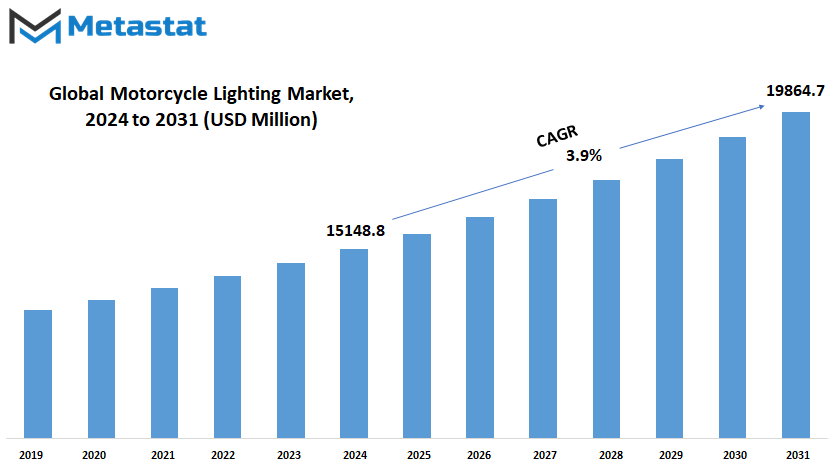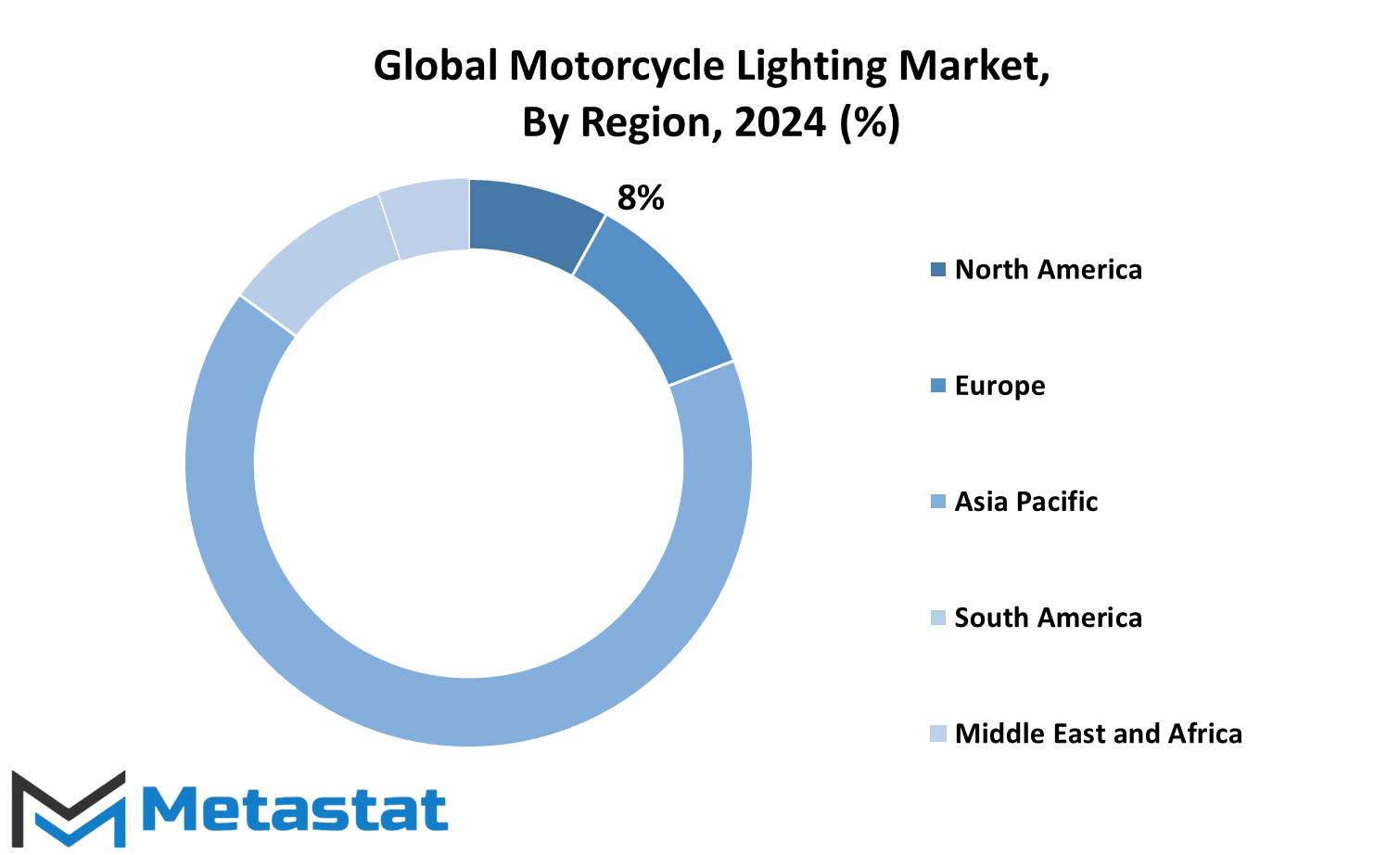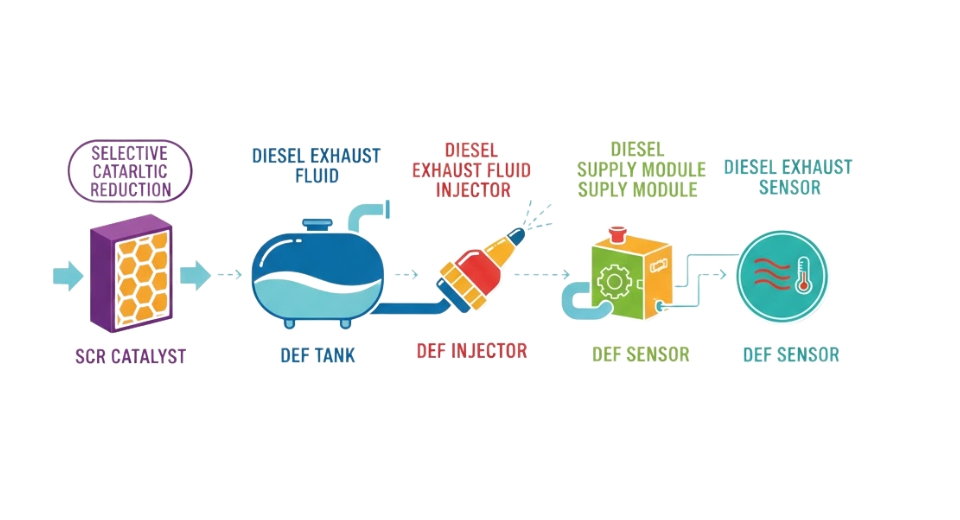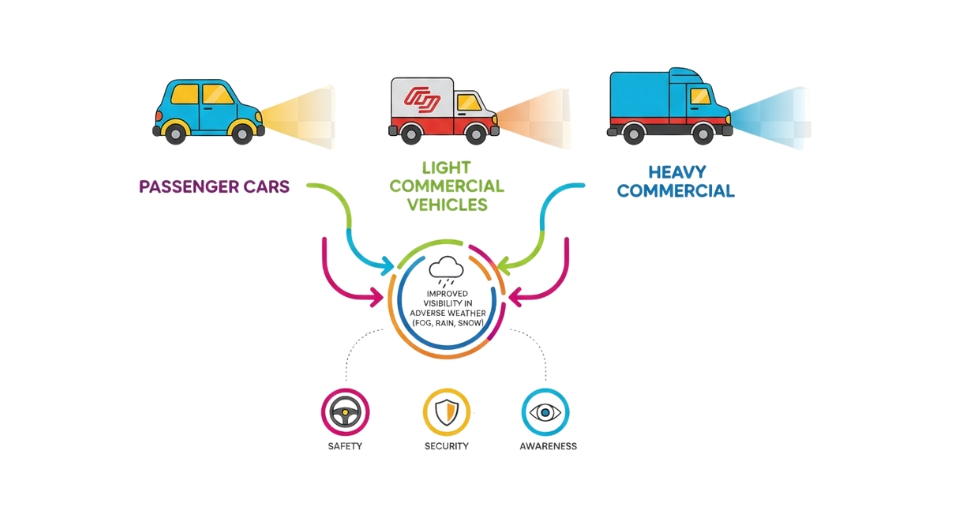MARKET OVERVIEW
Global Motorcycle Lighting and Its Industry The global motorcycle lighting market along with its industry is that specialized sphere dealing in the development, production, and application of lighting solutions for motorcycles exclusively. This market contributes much to the safety functionality, and aesthetic appeal of motorcycles worldwide among an array of different regions and consumer bases. As there is growth in automotive technology coupled with changing customer wants, motorcycle lighting today has become a responsive industry that deals with innovation, efficiency, and sustainability.
The Global Motorcycle Lighting market essentially caters to the production of headlamps, tail lamps, indicators, and auxiliary lamps required for better visibility and road communication. These lighting systems are not only functional; they are also an integral part of the motorcycle’s overall performance and visual design. In this market, manufacturers create products that deliver brightness, energy efficiency, and durability in tandem for applications requiring stringent safety standards, while still conforming to changing design trends. The market encompasses a variety of lighting technologies, such as halogen, xenon, and LEDs, with the latter increasingly so, given their higher efficiency and longer lifespan. The Global Motorcycle Lighting market will further expand its horizon with changing preferences of consumers for advanced features and smart technologies.
Also, it is seen that demand is growing for implementing adaptive lighting systems, with intensity and direction adjusted based on riding conditions, in order to improve both safety and user experience. In addition, a connected and intelligent lighting system is going to transform the industry, in conjunction with broader trends toward vehicle automation and connectivity. Such innovations identify the true seriousness of the industry toward meeting the requirements and enhancing overall experience while riding. The market is primarily affected by regional differences, since different markets have distinct preferences as well as regulatory demands. For example, European and North American regions tend to focus on strict safety standards and high-performance factors, hence there is a demand for advance lighting solution in these regions.
In Asia-Pacific, however, especially in motorcycle- dominant markets, demand is more economical but reliable lighting systems. This geographical diversity allows market players the opportunity to diversify their products and into various regions. The competitive landscape of the Global Motorcycle Lighting market includes established automotive lighting manufacturers as well as emerging players specialized in niche solutions. Both manufacturing companies and emerging players heavily invest in research and development to meet expectations with cutting-edge solutions that serve sustainability goals and customer needs. Growing adoption of electric motorcycles continues to diversify the market, as lighting systems for such vehicles often entail specific considerations about energy use in comparison with electric powertrains. In the near future, the Global Motorcycle Lighting market will evolve in response to changing regulatory standards, consumer demands, and technological advancements. Following appeals from governments and other organizations for energy-efficient and eco-friendly transport solutions, motorcycle lighting systems are likely to align with objectives concerning sustainability.
This may also boost innovations in communication-based lighting technologies with the rise of autonomous and semi-autonomous motorcycles, creating new paths for expansion and transformation. Conclusion In conclusion, the Global Motorcycle Lighting market represents a critical sector where safety, efficiency, and innovation become synonymous with the design and functionality of motorcycles. As it evolves, it will reflect at once technological advancements, frameworks set by regulatory authorities, and consumers’ preferences that will define a future defined by lighting systems in the motorcycle experience.
Global Motorcycle Lighting market is estimated to reach $19864.7 Million by 2031; growing at a CAGR of 3.9% from 2024 to 2031.

GROWTH FACTORS
The Global Motorcycle Lighting market is witnessing notable growth due to several factors driving its expansion. As motorbikes become a preferred mode of transportation for many, particularly in urban areas, the demand for advanced lighting systems is rising. Improved safety awareness among consumers and strict government regulations mandating enhanced visibility for motorcycles are critical growth factors. High-performance lighting solutions also enhance riders' visibility but, more importantly, they enhance their ability to be seen by other road users, largely reducing the chances of accidents. Such advantages have made LED and adaptive headlights, to name just a few, gain quite high traction in motorcycle adoption.
Technologies are the cornerstone to which the future Global Motorcycle Lighting market should look back. The manufacturers are more focused on inbuilt smart lighting equipment with automatic beam adjustment, dynamic indicators, and energy-efficient designs. These developments not only enhance the safety and functionality of motorcycles but also align with the broader shift toward sustainable solutions. As electric motorcycles gain popularity, there is an increasing demand for lighting systems that complement their eco-friendly nature while maintaining high energy efficiency.
However, there are significant challenges that need to be addressed so that Global Motorcycle Lighting market may grow at a healthy pace. A significant barrier could be the high cost associated with advanced lighting systems, which can impede its adoption in many markets, especially in value-sensitive markets. Moreover, the intricate integration of complex lighting systems in motorcycle designs might prove troublesome to manufacturers. Nonetheless, the future of the market is bright due to technological advances and safety and sustainability considerations.
Going forward, further growth in the market will be witnessed, driven by the increased uptake of electric and autonomous motorcycles. Improving technologies will unlock new applications for lighting manufacturers to develop customized systems meeting distinctive needs. For example, a lighting system that automatically adapts to weather or road conditions could become a standard element in high-performance motorcycles. Lighting systems could even be communicating among other vehicles and infrastructure, keeping in mind the important emphasis on connectivity and smart technology integration leading to road safety.
While there are challenges such as cost and complexity, the Global Motorcycle Lighting market will grow. With technological innovation and a spotlight on safety and efficiency, this market promises a future full of advanced solutions regarding meeting the fast-changing needs of riders and the motorcycle industry. Trends point toward a future in which lighting systems will play an important role in transforming motorcycle design and functionality.
MARKET SEGMENTATION
By Type
The global motorcycle lighting market is considered to experience high growth in the coming years. Technological advancements as well as rising demand for safer and more efficient motorcycles are driving these expectations. Lighting systems play an important role in motorcycles. Not only do they help increase visibility in all conditions, but they also influence the motorcycle's aesthetic value and overall design aspect. As the industry continues innovating, the role of lighting has expanded from simple functionality to elements that make the riding experience better.
By type, the market can be segmented into headlamps, taillamps, and other components such as indicators, switchgear, and brake lights. Headlamps are an important category, in which manufacturers continue to focus their efforts as their importance in improving nighttime visibility and total road safety cannot be overstated. Highly advanced headlight technologies, which include LED and laser lighting, are increasingly popular. LEDs and laser lighting provide much greater illumination intensity, energy efficiency, and durability compared to traditional halogen lamps. This trend is expected to grow in the future with electric and hybrid motorcycles due to their energy efficiency and optimal utilization of the battery capacity.
Taillamps are equally important, facilitating rear visibility as well as indicating to following vehicles that the rear brakes are being applied. Modern taillamps often use LED technology, delivering brighter illumination and a longer lifespan. LEDs also provide so much in the way of compact size and design flexibility to allow for creative shapes and designs that respond to consumer needs. Functionality and style combine to be the primary impetus in this product group.
Other lighting elements, for instance, indicator lights and brake lights, are used to contribute towards ensuring safety while riding and complying with the guidelines and regulations in the traffic. The smart lighting that adjusts brightness according to ambient conditions or the speed of the vehicle is increasingly becoming popular. These systems reflect a shift into intelligent transportation solutions for improving safety and convenience.
The Global Motorcycle Lighting market is expected to benefit from a rising focus on sustainability and energy efficiency. Governments and organizations worldwide are introducing regulations encouraging the adoption of eco-friendly technologies which further supports the development and integration of advanced lighting systems. As consumer expectations continue to evolve, the market will likely see more personalized and adaptive lighting solutions to cater to the needs of many while improving overall safety and visibility.
Looking forward, the integration of connected technology into motorcycles will potentially unlock new avenues for lighting systems, such as interaction with other vehicles or infrastructure. These innovations will show that the Global Motorcycle Lighting market will continue to grow based on advancements considered in terms of safety and efficiency, as well as satisfaction for the rider.
By Light Type
The global motorcycle lighting market is remarkably growing as advancements in technology shape the future of transportation. Lighting systems are a critical component of motorcycles, offering illumination not just for riders but also enhancing safety and visibility on roads. The market is expected to continue growing in the years ahead, supported by rising focus on safety standards and innovative design.
As far as the type of light goes, the market is broadly divided into LED lights, halogen lights, and other types. The LED lights are rapidly emerging as the favorite due to greater energy efficiency, durability, and higher luminescence. They consume much less power, have a longer lifespan, and provide better light than their traditional counterparts. This makes them particularly appealing in a time when sustainability and efficiency are key priorities for manufacturers and consumers alike. In addition, with the automotive industry trending towards more extensive smart technology integration, LED lights are rapidly being adopted as integral parts of systems featuring adaptive lights, thus increasing their appeal. Halogen lamps are a more traditional type and remain within the ambit of market share in regions where the cost-effectiveness of the light blends better with its demand rather than sophisticated features. Other forms of lighting technologies also exist for the sake of further niches and customized motorcycle designs.
The rising popularity of motorcycles in populated urban areas and increasingly as new economies is therefore driving the growth of this market. These are being used increasingly as a more efficient and affordable mode of transport, and, in this parallel move with growing demands, better lighting solutions have been required. Regulatory requirements regarding lighting for vehicles have also played an important role, as most countries demand quality lighting systems to ensure safety on roads.
The global motorcycle lighting market is likely to be further shaped by trends such as the adoption of electric motorcycles and integration of connected technologies. Lighting systems on electric motorcycles need to be matched with their look and energy requirements, thus advancing innovation in this field. Adoption of smart features such as automatic brightness adjustment and communication with other vehicles is expected to transform the field significantly.
Overall, the global motorcycle lighting market presents a promising future, driven by advancements in technology and growing demand for safer, more efficient transportation solutions. Manufacturers who focus on innovation and sustainability are well-positioned to benefit from these trends.
By Vehicle Type
The Global Motorcycle Lighting market will likely see significant growth due to technological innovation and growing concerns over the environment. Lighting for motorcycles, though largely ignored, is a crucial and integral factor for both safety, aesthetics, and energy efficiency. These lighting systems are quickly evolving in response to modern riders and manufacturer needs, with emphasis on sustainability and innovation. The market could be broadly segmented into internal combustion (IC) engine motorcycles and electric vehicles (EVs). Each segment would offer unique opportunities for growth, driven by advancements in lighting technologies.
In the case of IC engine segment, high demand for efficient lighting systems continues due to the dominance of these vehicles in many regions, particularly developing economies. Halogen, LED, and laser lighting technologies are being utilized to improve visibility and durability. LEDs, in particular, have gained traction due to their energy efficiency and ability to reduce maintenance costs. Motorcycles using IC engines constitute a large part of the market, so their makers are sure to work towards smart lighting solutions that enhance the vehicle safety features. Some of these features include headlights which adapt according to road conditions or angle.
On the other side, EVs have brought a drastic turn in how lighting systems are designed and implemented. The priorities include lightweight and efficient energy components that maximize the potential of the vehicle. As a result, high-tech lighting systems, including OLEDs (organic light-emitting diodes), have experienced a growing popularity due to their flexibility and minimal energy consumption. In addition, EVs are frequently envisaged with designs that must be slim and flexible to match aesthetic demands. Such aspects add to the appeal of the vehicle but they are in sync with the sustainable objectives as well due to lower energy and waste material usage.
As consumer awareness about safety and environmental impact grows, the motorcycle lighting market will emerge for further innovation. Integration of IoT and AI technologies in lighting systems would enhance features such as automatic dimming, better visibility during adverse weather, and ensured night-time safety. The strict regulations by the governments across the globe on the vehicle safety standards have also prompted the manufacturers to invest more in the advanced lighting technologies.
The global motorcycle lighting market has significant potential as traditional motorcycles and electric motorcycles pivot to ascertain changing consumer choice and the possibilities presented by technology. Safety, energy efficiency, and design will transform how riders experience transportation around the world.
By End-Users
The Global Motorcycle Lighting market was growing at a rapid rate and was destined to expand further into the forthcoming years. The growth can be mainly ascribed to the ongoing technological development in motorcycles, ever-growing safety concerns, and the rising numbers of motorcycle users worldwide. The market is divided into two significant end-user categories: Original Equipment Manufacturers (OEMs) and the aftermarket. Both are equally important to determine the direction of this business.
OEMs are the primary players guiding innovation within the motorcycle lighting market. They undertake the initial steps in introducing advanced technologies such as LED systems, adaptive headlights, and energy-efficient lighting into the vehicle. Such innovations tend to promote improved visibility, safety, and the latest style for consumers. Also, manufacturers focus on sustainability; they use materials and designs that will consume less energy. It is through such a focus on innovation that OEMs have emerged as a major player in the growth of the market.
The aftermarket market is driven by motorcycle owners who seek to upgrade or replace their current lighting systems. This is the segment which actually has huge customers demanding low-cost and tailored lighting solutions. The numerous options available in the aftermarket allow riders to select the lighting they prefer so they are better equipped with increased visibility and safety. With increased awareness regarding quality lighting avoiding potential accidents, this segment still experiences increased demand.
Going forward, the Global Motorcycle Lighting market is on the verge of great growth, influenced by several key drivers. Urbanization and growing demand to attain efficient means of transportation would result in higher motorcycle sales. Along with that, smart technologies like Internet of Things (IoT) capabilities and sensor-based lighting are expected to change the game. It would be able to make the lighting systems evolve to adapt dynamically according to road conditions, thus resulting in safer and more intuitive ride modes.
Governments around the world are enforcing more rigorous safety standards, which makes the manufacturer and consumer scrutinize the quality of their lighting system. This regulatory action, coupled with improved lighting technology, will be a sufficient catalyst in encouraging the basic adoption of innovative solutions by both OEM and aftermarket segments.
The Global Motorcycle Lighting market is on a promising trajectory, supported and fueled by technological innovation, such as electronics, materials, and manufacturing. As the OEM and aftermarket sectors continue to evolve, it is well-positioned to progress in meeting future consumer demands while making the riding experience exciting.
|
Report Coverage |
Details |
|
Forecast Period |
2024-2031 |
|
Market Size in 2024 |
$15148.8 million |
|
Market Size by 2031 |
$19864.7 Million |
|
Growth Rate from 2024 to 2031 |
3.9% |
|
Base Year |
2022 |
|
Regions Covered |
North America, Europe, Asia-Pacific Green, South America, Middle East & Africa |
REGIONAL ANALYSIS
The market for motorcycle lighting now represents a significant portion of the automotive sector, as it reflects not only technological growth but also increases in demand for safety and style by customers. If market patterns are studied from a region-based point of view, it can easily be identified how diverse regions contribute toward its development as well as its growth.
The countries included in the North America motorcycle lighting market are the United States, Canada, and Mexico. This is an area that has a great emphasis on innovation and safety regulation, driving the demand for more efficient and durable lighting systems. Consumers here demand aesthetic appeal and performance; hence, adoption of advanced LED and adaptive lighting technologies is driven. Besides improving visibility for riders, these developments also enhance the overall motorcycle travel safety.
In Europe, Germany and the UK in particular, along with France, and Italy are the major players in terms of motorcycle lighting market contribution. Being known for their intense automotive industries, these nations emphasize energy efficiency and an adherence to the most stringent environmental standards. Their response is doing the research and development of lighting systems to meet these needs. European consumers also prefer to get stylish designs, making the companies develop products by combining functionality with modern styling. Premium motorcycles in that region further support the growth of the market.
Asia-Pacific, which includes India, China, Japan, South Korea, and more, is turning out to be a hub for the motorcycle lighting market. The regions with high population density and rapid urbanization drive motorcycle industries, causing an increase in demand for the advanced lighting solutions. Motorcycles are one of the primary modes of transportation in countries like China and India, hence, the emphasis on safety enhancement would be critical. Manufacturers are developing such cost-effective technologies to cater to this price-sensitive market but would insert innovative features for being a tech-savvy customer.
In South America, notable markets include Brazil and Argentina. The motorcycle lighting market is influenced by the growth in adoption for personal and commercial use. Economic considerations are key influences on purchase decisions, so suppliers will have a need to provide economical yet reliable lighting solutions. In the Middle East and Africa, including GCC countries, Egypt, and South Africa, urban and rural demand will influence the market. These regions will need strong illumination systems to endure the varying climatic conditions.
With advancing technologies and increased consumer awareness, the global motorcycle lighting market is well on its way to further growth, this time catering to regional requirements and pushing new safety and design boundaries.

COMPETITIVE PLAYERS
The Global Motorcycle Lighting market has experienced significant growth, fueled by increasing demand for advanced and energy-efficient lighting systems in the automotive industry. As motorcycles continue to serve as a popular means of transport, lighting technologies are evolving to enhance safety, performance, and aesthetics. Key players such as J.W. Speaker Corporation, Fiem Industries Limited, Uno Minda Limited, OSRAM GmbH, and Koninklijke Philips N.V. are driving innovation to meet consumer demands and regulatory requirements, creating an industry that is highly competitive and dynamic.
The rise in motorcycle production globally has spurred the need for improved lighting solutions that prioritize visibility and energy efficiency. LED technology, for instance, has gained widespread adoption due to its longevity and lower power consumption. Manufacturers are also investing in adaptive lighting systems that adjust based on road conditions and visibility requirements. This trend is expected to define the future of the Global Motorcycle Lighting market, with advancements aimed at improving rider safety and environmental sustainability.
Competition among leading companies is intensifying as they strive to offer cutting-edge solutions. Businesses like Varroc Group, PIAA Corporation, and Hella KGaA Hueck & Co. are focusing on research and development to bring forward lighting products that align with changing consumer expectations. Emerging technologies, including smart lighting systems that integrate with other motorcycle components, are becoming a focal point for innovation. Additionally, collaborations between manufacturers and technology firms are opening avenues for the creation of next-generation products.
The industry also faces challenges, such as fluctuating raw material costs and stringent government regulations on energy usage. However, these hurdles are driving companies to explore alternatives and refine their manufacturing processes. For instance, advancements in material science are enabling the production of durable and lightweight lighting components, which contribute to overall fuel efficiency. Companies like NAOEVO Lighting and Koito Manufacturing Co., Ltd., are at the forefront of these developments, shaping the competitive landscape with their forward-thinking strategies.
Looking ahead, the Global Motorcycle Lighting market is poised to witness further transformation. The growing emphasis on electric and autonomous motorcycles will push lighting technologies to adapt, creating new opportunities for manufacturers. Businesses like Lumax Industries Ltd and UM Group are likely to play a pivotal role in this evolution, as they continue to focus on innovative and sustainable solutions. With constant technological progress and fierce competition, the market is set to expand, catering to the diverse needs of motorcyclists worldwide. This dynamic environment highlights the promising future of the industry.
Motorcycle Lighting Market Key Segments:
By Type
- Headlamp
- Taillamp
- Others (Indicators, Switchgear, Brake Lights, etc.)
By Light Type
- LED Lights
- Halogen Lights
- Others
By Vehicle Type
- IC Engine
- EV
By End-Users
- OEM
- Aftermarket
Key Global Motorcycle Lighting Industry Players
- J.W. Speaker Corporation
- Fiem Industries Limited
- Uno Minda Limited
- OSRAM GmbH
- Koninklijke Philips N.V.
- UM Group
- Varroc Group
- PIAA Corporation
- Hella KGaA Hueck & Co.
- NAOEVO Lighting
- Koito Manufacturing Co., Ltd.
- Lumax Industries Ltd.
WHAT REPORT PROVIDES
- Full in-depth analysis of the parent Industry
- Important changes in market and its dynamics
- Segmentation details of the market
- Former, on-going, and projected market analysis in terms of volume and valuAssessment of niche industry developments
- Market share analysis
- Key strategies of major players
- Emerging segments and regional growth potential








 US: +1 3023308252
US: +1 3023308252






